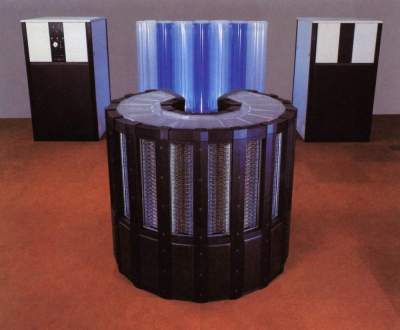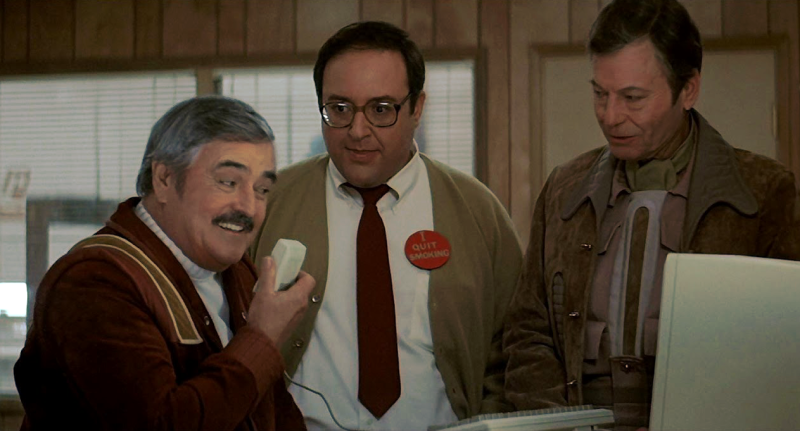1986: The US and Russia signed arms agreements, Argentina won the world cup, and Star Trek IV: The Voyage Home hit the theaters. Trekkies and the general public alike enjoyed the film. Some astute hams though, noticed a strange phenomenon about halfway through the film. During a pivotal scene, Scotty attempts to beam Chekov and Uhura off the Enterprise, but has trouble with interference. The interference can be heard over the ubiquitous Star Trek comm link. To many it may sound like random radio noise. To the trained ear of a [Harold Price, NK6K] though, it sounded a heck of a lot like packet radio transmissions.
 By 1989, the film was out on VHS and laser disc. With high quality audio available, [Harold] challenged his friend [Bob McGwier, N4HY] to decode the signal. [Bob] used the best computer he had available: His brain. He also had a bit of help from a Cray 2 supercomputer.
By 1989, the film was out on VHS and laser disc. With high quality audio available, [Harold] challenged his friend [Bob McGwier, N4HY] to decode the signal. [Bob] used the best computer he had available: His brain. He also had a bit of help from a Cray 2 supercomputer.
[Bob] didn’t own his own Cray 2 of course, this particular computer was property of the National Security Agency (NSA). He received permission to test Frequency Shift Keyed (FSK) decoder algorithms. Can you guess what his test dataset was?
The signal required a lot of cleanup: The original receiver was tuned 900 Hz below the transmission frequency. There also was a ton of noise. To make matters worse, Scotty kept speaking over the audio. Thankfully, AX.25 is a forgiving protocol. [Bob] persevered and was able to obtain some usable data. The signal turned out to be [Bill Harrigill, WA8ZCN] sending a Receive Ready (RR) packet to N6AEZ on 20 meters. An RR packet indicates that [Bill’s] station had received all previous packets and was ready for more. [Bob] called to [Bill], who was able to verify that it was probably him transmitting in the 1985 or 1986, around the time the sound editors would have been looking for effects.
That’s a pretty amazing accomplishment, especially considering it was 1989. Today, we carry supercomputers around in our pockets. The Cray 2 is roughly equivalent to an iPhone 4 in processing power. Modern laptop and desktop machines easily out class Seymour Cray’s machine. We also have software like GNU Radio, which is designed to decode data. Our challenge to you, the best readers in the world, is to replicate [Bob McGwier’s] work, and share your results.
















If you found this amusing, you might be interested in this blog – http://www.windytan.com/. It’s done by a person who likes to finds signals and decode them. She’s done lots of interesting projects like the one described here.
LOVE her work – thanks for the reminder! Her ‘sound of dial-up’ is a classic:
http://www.windytan.com/2012/11/the-sound-of-dialup-pictured.html
Oona is awesome! We’ve covered a lot of her work – most recently her pea whistle stenography: http://hackaday.com/2015/11/16/pea-whistle-steganography/
I can verify that this kind of thing happens.
I worked on Star Trek: First Contact, and my job was doing the Borg suit electronics (along with electronics for the spacesuits and some animatronics in that film). The Borg lights aren’t just blinking; I programmed them to flash messages in slow Morse code. The electronics in the Borg makeup (not my department) are also signaling in somewhat faster Morse code. You’d never be able to read more than a character or two due to editing, but it amuses me to know they’re there nonetheless. I’ve never told anyone what it is the Borg are saying. ;-)
Wow, you are that guy! Watching “First Contact” I imagined how much fun making the Borg props had been, and what kind of micro controllers you guys used.
Also noticed that the blinking pattern was non repetitive, which was noticeable because most movie prop guys usually just have a simple repeating pattern for blinking lamps in movies.
PIC16C56 on the Borg drones, and a PIC16C58 on the Borg queen. This was 20 years ago, after all. And yes, it was fun! I was a huge fan as a kid, so it was awesome to get a call to come actually work on Star Trek.
Awesome. Another excuse to watch First Contact
So what are they saying? “Resistance isn’t futile”?
Probably more like, “I can’t believe I’m doing this. I graduated from RADA, you know.”
(c:
;-)
Resistance isn’ futile,particularly if you have capacitance and there is resonance with other likeminded people.
I vaguely remember people mentioning that the blinks were morse code back when first contact came out. The star trek wiki mentions the eye pieces (I’m guessing that’s the makeup crew you mentioned) blinked names of the production staff. It’s great to see you reading Hackaday!
Damn Ham Radio operator! Nearly got Chekov killed! All for a few data packets. B^)
Star Trek IV was mentioned an nobody quoted anything from the most quotable Star Trek ever? Unacceptable!!!
I’ll help.
Could direct me to the nuclear wessels?
Helllllo computer.
Well double dumbass on you!
There be whales captain!
The doctor gave me a pill and now I’ve got new kidneys!
Well how do you know he didn’t invent the bloody thing?
*”Admiral, there be whales here!”
I use “Helllllo computer” often when my computer is frozen or otherwise not cooperating.
Hey, I used the “hello computer” bit as the featured image for the article :) Had to get it in there somehow!
Everybody remember where we parked!
You dog gone humans. All over a sound. And he did.
The GNU Radio Framework is really not “designed to decode data” at all! You can “connect” things to GNU Radio to decode data streams though.
Whaaa? GR can definitely decode, demodulate, encode, modulate, filter, etc. Their focus is on software radio, but it really works for any form of streaming data processing. I would love to try running this movie’s audio through a carefully designed GNURadio graph and seeing packets (or fragments) come out the other end.
It certainly should. I tremendously enjoyed doing the first software radio work in the 1980’s and I’m really glad to see it take off in directions I never imagined.
73 (ham-talk for good luck) Bob
N4HY
I work with Bob McGwier’s son! Bob seems to have a ton of early computer experience under his belt. He’s currently working on getting amateur radio satellites into space
http://www.amsat.org/?p=4058
Tell my son I love him and,to call his dad.
While current computers can boast more CPU power than an old Cray 2, they still haven’t quite caught up in terms of (main) memory bandwidth. Because the largest RAM chips at the time were only 2 KB in size, a fully equipped Cray 2 with 32 MB required 16384 RAM chips across many boards to feed the multiple CPUs. This meant there were many “channels” to access main memory and hence it had really high total bandwidth. And because it had separate data and address lines, it could be accessed at top speed with random accesses. Modern computers multiplex their A/D lines and can only achieve top speed with “burst mode” transfers.
But Cray never would have said their machine had “32 MB”. They always specified memory capacity in “words”, where one word was one (Cray format) floating point number, which was the primary data type Cray programmers cared about. One such Cray word was 64 bits or 8 bytes, and so this 32 MB machine would have been called an 8 MWord machine.
Whoops — 4 MWord. :-)
But the startup latency to main memory was awful. Not unlike talking to GPU today.
No [HaD]. We do NOT “…carry supercomputers around in our pockets”.
“Supercomputer” used to be defined as: The 500 fastest computers in currently in operation. (there is still a top 500 list)
It has since been watered down by companies who like to claim they make “Supercomputers”. However, it STILL means “…the fastest computers in currently in operation”. Last time I checked, cell phones aren’t cranking out PFLOPS…
The actual subject of the article is pretty cool though. It’s always fun to find these kind of hidden things in the wild.
You must be fun at parties…
+1…..[Ian] should probably should drink more fluids, it’ll loosen up them bowels…..
@Ian
If you’re a native English speaker and didn’t understand that the statement meant we carry *yesteryear’s* supercomputers in our pockets then your reading comprehension is so catastrophically bad that I suspect underlying pathology.
Isn’t that the point?
HaD has a large non-native English readership. Saying something false, just because it sounds good, is poor writing.
I will admit that this is an edge case. But it does further water down the term “supercomputer”, which does not benefit anyone.
Further; I pointed this out to help someone improve. If I do something incorrectly (or even inefficiently) I HOPE that someone else has the courage to point it out to me, so I can learn to do it better in the future. I wasn’t just commenting to be an ass.
Even Further; Letting the lay-person misuse technical words is how words end up being meaningless. “The Cloud” and “Hacker” are two good examples of words that many people use, yet don’t understand the meaning of because they are often misuse.
Go with it Ian. I was laughing the entire time I was doing this work.
Maybe a nitpick, but I don’t believe that the Enterprise was in this movie. It had been blown up in Star Trek III and they were using a Klingon Bird of Prey.
They were on the aircraft carrier USS Enterprise CVN-65 not the star ship NCC-1701.
The USS Enterprise was in the movie (the US navy’s nuclear carrier) (CVN-65) http://memory-alpha.wikia.com/wiki/USS_Enterprise_(CVN-65)
But…Data wasn’t in Star Trek IV!!
:’)
A Ruskie enquiring about nuclear vessels during the cold war? Seems legit.
[youtube https://www.youtube.com/watch?v=MdSJFrhb-HM&w=560&h=315%5D
I love this movie and this was one of the most fun hack projects I’ve done